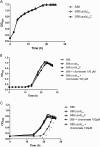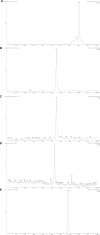The ssbL gene harbored by the ColV plasmid of an Escherichia coli neonatal meningitis strain is an auxiliary virulence factor boosting the production of siderophores through the shikimate pathway
- PMID: 24443535
- PMCID: PMC3993347
- DOI: 10.1128/JB.01153-13
The ssbL gene harbored by the ColV plasmid of an Escherichia coli neonatal meningitis strain is an auxiliary virulence factor boosting the production of siderophores through the shikimate pathway
Abstract
The ability to capture iron is a challenge for most bacteria. The neonatal meningitis Escherichia coli strain S88 possesses several iron uptake systems, notably including siderophores. Transcriptional analysis of the ColV plasmid pS88 has shown strong induction of a previously undescribed gene with low identity to three E. coli chromosomal genes encoding phospho-2-dehydro-3-deoxyheptonate aldolases involved in aromatic amino acid and catecholate/phenolate siderophore biosynthesis through the shikimate pathway. Here, we investigated the role of this gene, ssbLp (ssbL carried on the plasmid), in siderophore biosynthesis and, consequently, in S88 virulence. We constructed an S88 mutant designated S88 ΔssbLp, which exhibited reduced growth under low-iron conditions compared to the wild-type strain. Liquid chromatography-mass spectroscopy analysis of culture supernatants showed that the mutant secreted significantly smaller amounts of enterobactin, salmochelin SX, and yersiniabactin than the wild-type strain. The mutant was also less virulent in a neonatal rat sepsis model, with significantly lower bacteremia and mortality. Supplementation with chorismate, the final product of the shikimate pathway, restored the wild-type phenotype in vitro. In a collection of human extraintestinal E. coli isolates, we found that ssbL was present only in strains harboring the iro locus, encoding salmochelins, and was located either on the chromosome or on plasmids. Acquisition of the iro locus has been accompanied by acquisition of the auxiliary gene ssbL, which boosts the metabolic pathway essential for catecholate/phenolate siderophore biosynthesis and could represent potential therapeutic targets.
Figures





References
-
- Lankford CE. 1973. Bacterial assimilation of iron. Crit. Rev. Microbiol. 2:273–331. 10.3109/10408417309108388 - DOI
Publication types
MeSH terms
Substances
LinkOut - more resources
Full Text Sources
Other Literature Sources

